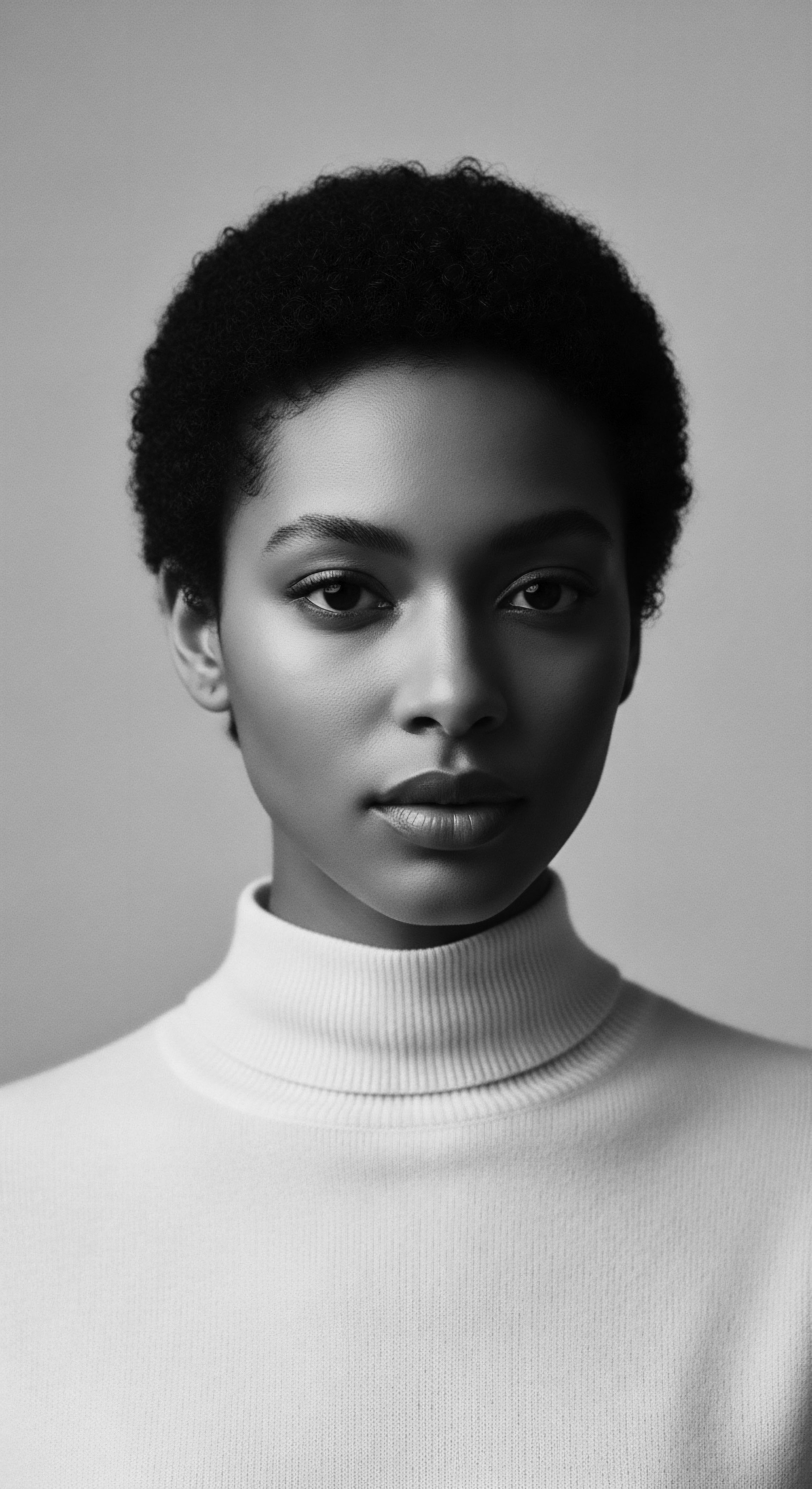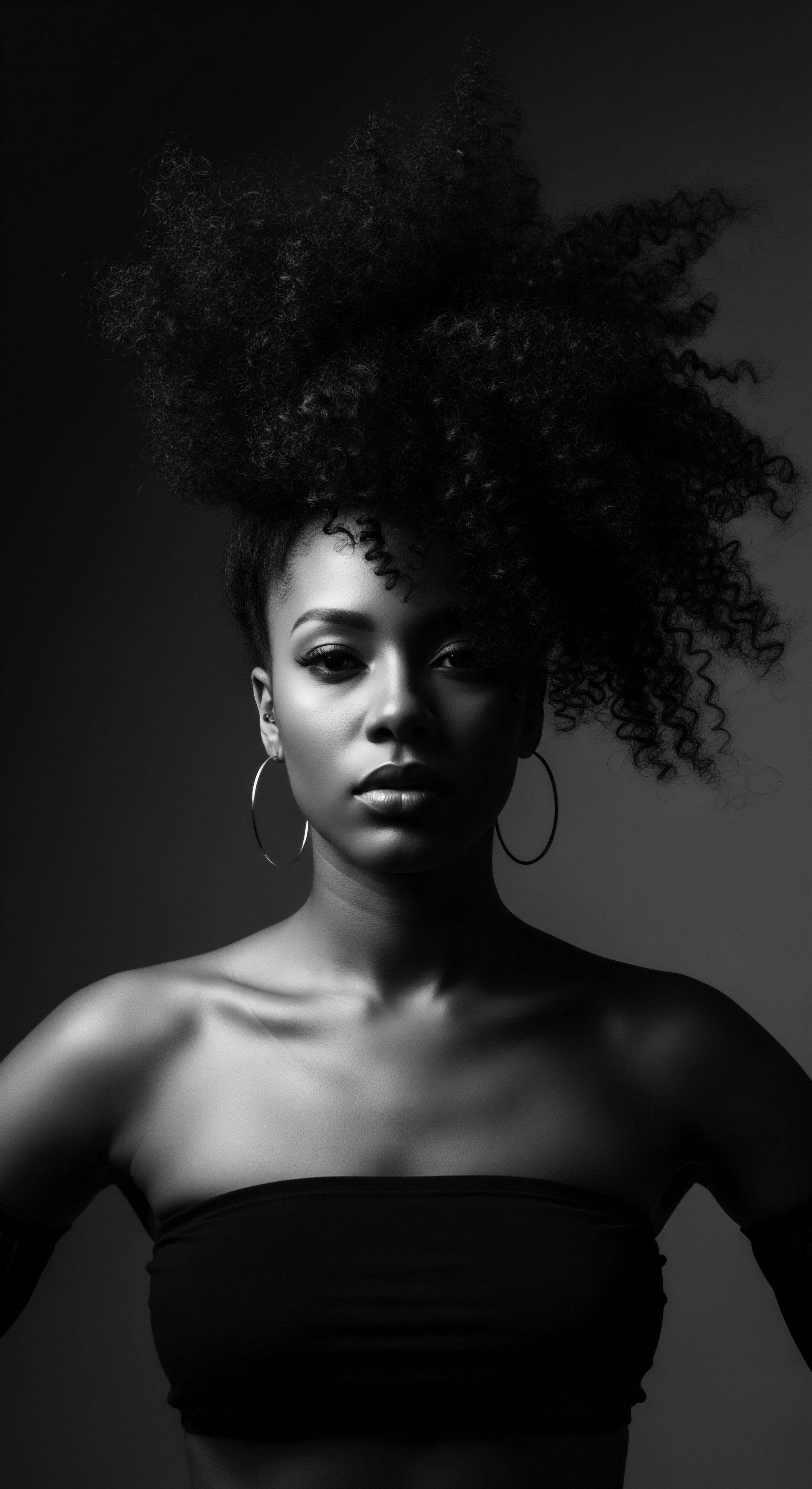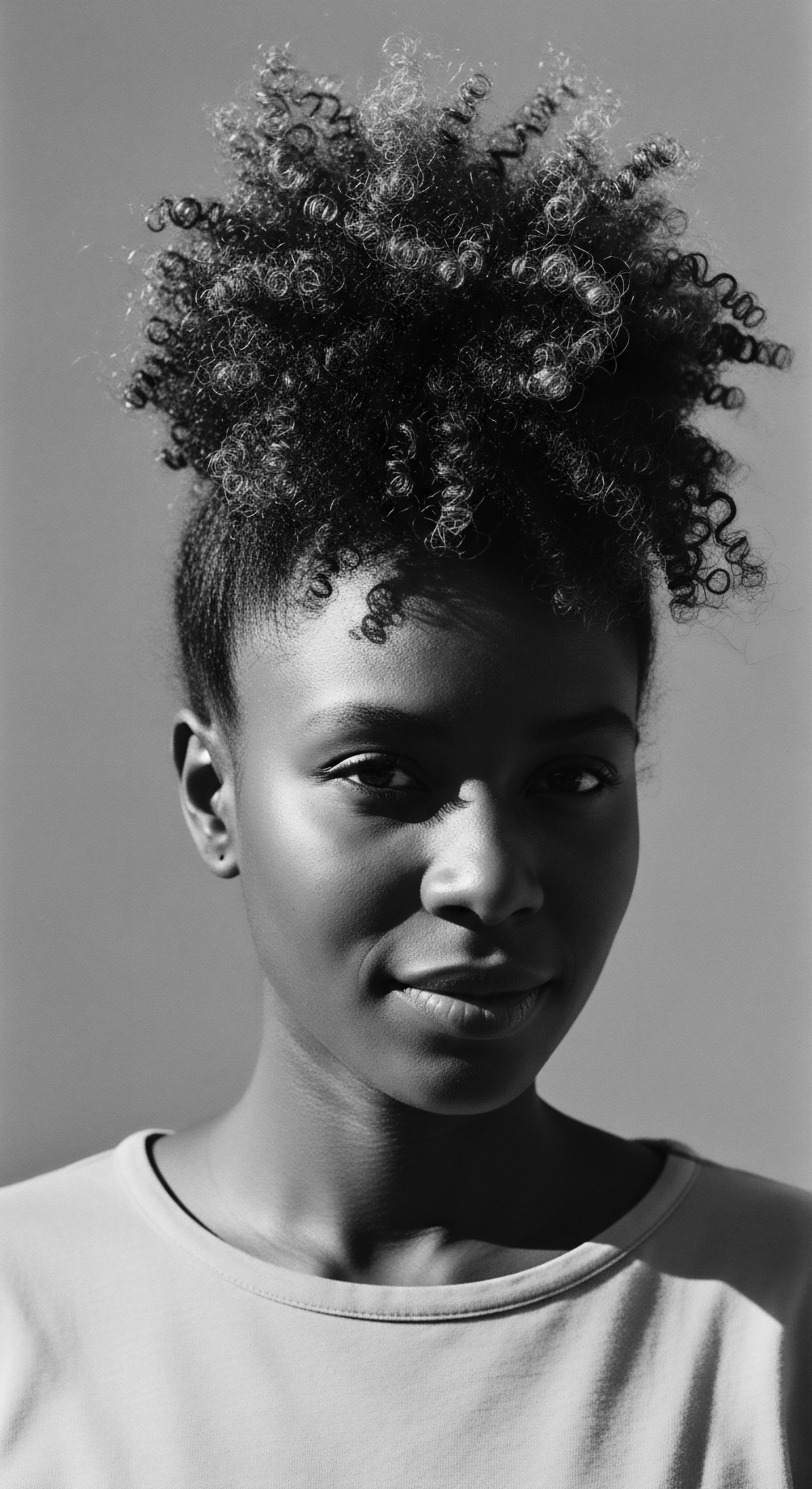
Roots
The story of textured hair, with its inherent longing for deep, sustained moisture, is not a simple tale of superficial needs. Instead, it forms a profound ancestral narrative, a testament to ancient wisdom and adaptation that speaks directly to the resilience of those who carry its heritage. To truly understand why these exquisite strands yearn for hydration, one must journey back to the very dawn of human experience, to the landscapes that shaped our ancestors and the biological architecture that emerged in response. This exploration unfolds as a living, breathing archive, where biology meets legacy, and the thirst of a strand echoes the journeys of generations.

Hair’s Ancient Design and Climate’s Call
The helical journey of a textured hair strand, a magnificent coil that defies simple linearity, began its intricate design not as a whimsical flourish, but as a masterpiece of biological engineering. Our earliest ancestors, navigating the intense solar radiation of equatorial Africa, faced a profound challenge ❉ how to protect a rapidly growing, heat-sensitive brain while minimizing water loss through sweat. The answer, as researchers have come to understand, lay partially in the unique morphology of their scalp hair.
Tightly curled hair creates a porous, insulating canopy, allowing air to circulate near the scalp while providing a shield against the sun’s direct assault. This distinctive structure offered effective protection against heat gain, lessening the body’s reliance on evaporative cooling, which preserved precious water in arid environments (Lasisi, 2023).
The story of textured hair’s moisture needs is an ancestral narrative, a testament to resilience forged in ancient landscapes.
The shape of the hair follicle itself plays a determining role in the curvature of the hair shaft. Follicles that are elliptical or asymmetrical, rather than round, produce the characteristic curls and coils of textured hair. The flatter the ellipse, the tighter the curl. This inherent curvature means that the natural oils, or sebum, produced by the sebaceous glands, face a more arduous journey traveling down the spiral length of the hair strand compared to straight hair.
Sebum, a protective, lipid-rich substance, is meant to lubricate and seal the hair cuticle, preventing moisture loss. In highly coiled hair, this natural distribution is less efficient, leading to inherent dryness along the hair shaft, particularly towards the ends.

The Ancestral Lipid Veil’s Slow Descent
Sebaceous glands, those tiny structures residing within the skin alongside each hair follicle, generate sebum. This oily substance forms a natural, protective layer for both the skin and hair. In textured hair, with its remarkable twists and turns, the path for this lipid veil is fraught with obstacles. Each bend, each spiraling curve, presents a point where sebum transfer slows or halts.
Consequently, while textured hair may possess an external lipid layer primarily from sebaceous glands, the internal lipid content, which also contributes to moisture retention, can differ across hair types. Research indicates that internal lipids are more prominent in European and Asian hair, contributing to moisture retention and UV radiation resistance. Despite having a higher surface lipid content from sebum, the structural characteristics of Afro-textured hair, specifically its high curvature, often result in lower overall hydration levels, leaving it prone to dryness. This physiological reality, shaped over millennia, meant that early human populations with textured hair quickly discerned the necessity of external moisturizing practices to supplement their body’s own efforts.

The Sacred Lexicon of Hair Anatomy
To speak of textured hair is to engage with a language that transcends mere biology, encompassing terms that reflect its heritage, its strength, and its unique needs. Understanding the architecture of the strand itself provides a foundation for appreciating why its specific moisture requirements are so deeply embedded.
- Cuticle ❉ The outermost layer, composed of overlapping, scale-like cells that protect the inner core. In textured hair, these scales may be more raised or irregular, contributing to moisture evaporation.
- Cortex ❉ The primary portion of the hair shaft, composed of tightly packed keratin proteins. The arrangement of these proteins and their disulfide bonds influences curl pattern and strength.
- Medulla ❉ The innermost core, a loosely arranged channel that is not always present in finer hair strands. It contributes to hair volume and can play a role in thermoregulation through its internal lipid content.
The interplay of these layers, particularly the cuticle’s integrity and the cortex’s structure, dictates how well a strand holds water. The very coils that offered ancestral protection from the sun also presented a dilemma ❉ a path less traveled for natural scalp oils, necessitating human ingenuity to maintain vitality.

Ritual
The understanding of textured hair’s distinct thirst, a wisdom passed through oral traditions and hands-on practices, laid the groundwork for ancestral rituals of care. These were not mere acts of grooming; they were profound ceremonies of preservation, expressions of cultural identity, and ingenious responses to biological imperatives. The techniques, tools, and transformations associated with textured hair have a deep heritage, directly shaped by the inherent need for moisture and protection.

How Did Styling Practices Serve Moisture Needs?
From the intricate cornrows of ancient West African civilizations to the meticulously coiffed looks of Nubian queens, styling was a deliberate act of care. These practices extended beyond aesthetic appeal; they served a fundamental purpose in managing moisture and protecting the delicate strands from harsh environmental elements. When hair is left loose, each individual coil is exposed to the air, accelerating moisture evaporation.
By contrast, styles that gather and secure the hair, often close to the scalp, reduce the surface area exposed, thereby conserving hydration. This practical function highlights a crucial aspect of their ancestral design.
Ancient styling practices for textured hair were profound ceremonies of preservation, expressions of cultural identity, and ingenious responses to biological imperatives.
Protective styles, a term familiar in contemporary hair care, are indeed a continuation of this heritage. They are built upon the wisdom of securing hair to prevent breakage, minimize manipulation, and, vitally, to seal in moisture. Braids, twists, and various forms of coiling or wrapping hair, often performed with the aid of natural emollients, encapsulate the strand, creating a micro-environment that helps to retain the water content necessary for elasticity and strength. This intergenerational knowledge of how to create resilient, enduring styles directly addresses the physiological requirements of hair that struggles to distribute its own sebum.

The Ancestral Apothecary of Hydration
The ingenuity of our ancestors is vividly demonstrated through their deep knowledge of the plant kingdom. The lands where textured hair first flourished were rich with botanicals that offered solutions to the hair’s persistent moisture needs. These plant-based emollients and humectants became the foundation of hair care.
Consider shea butter, derived from the nuts of the African shea tree (Vitellaria paradoxa), which has been a staple across West Africa for centuries. Its rich lipid profile made it an ideal sealant, providing a protective coating that minimized water loss from the hair shaft. Similarly, various plant oils, like castor oil and almond oil, were used in ancient Egypt to moisturize and shield hair from arid climates, underscoring a consistent understanding of botanical properties for hydration across diverse regions.
| Traditional Ingredient Shea Butter (Vitellaria paradoxa) |
| Ancestral Use for Moisture Protective sealant, emollient for dryness from sun and wind. |
| Modern Scientific Link Rich in fatty acids (oleic, stearic), forms occlusive barrier, reduces transepidermal water loss. |
| Traditional Ingredient Castor Oil (Ricinus communis) |
| Ancestral Use for Moisture Moisturizer, protective shield in arid climates. |
| Modern Scientific Link High in ricinoleic acid, a humectant and emollient, draws and seals moisture. |
| Traditional Ingredient Coconut Oil (Cocos nucifera) |
| Ancestral Use for Moisture Deep conditioning, frizz control, moisture sealing. |
| Modern Scientific Link Saturated fatty acids (lauric acid) penetrate hair shaft, reduce protein loss, seal cuticle. |
| Traditional Ingredient Ancestral wisdom concerning botanical agents laid the groundwork for contemporary hair science. |

Tools That Echo Through Time
The implements used for textured hair care also tell a story of adaptation and community. From simple bone combs to elaborately carved wooden picks, these tools were designed to navigate the unique structure of coiled hair without causing damage. A wide-toothed comb, for instance, became essential for detangling, preserving the delicate bonds within each curl cluster and minimizing breakage, which in turn helps hair retain its integrity and, consequently, its moisture. These tools were not just functional; they often held symbolic significance, passed down through families, embodying the heritage of care.
The act of styling was often a communal endeavor, a moment of shared heritage and conversation. Gathering to braid or adorn hair created spaces for the transmission of knowledge, where insights on effective moisturizing techniques, the best plants for conditioning, or the most resilient styles were exchanged. This communal aspect reinforced the value of proper hair care, embedding the understanding of its moisture needs into the very fabric of social life.

Relay
The journey of textured hair’s specific moisture needs from ancestral adaptation to modern understanding marks a fascinating relay of wisdom, where the insights gleaned from ancient practices are now often affirmed by scientific inquiry. This deep exploration moves beyond surface observations, delving into the biological intricacies that underscore the hair’s demand for hydration and how our understanding of this biology is shaped by a rich heritage.

Validating Ancestral Hydration Through Science
Modern scientific research continually provides a fuller picture of the unique characteristics of textured hair that contribute to its hydration requirements. The hair shaft, which is elliptical in cross-section for coiled strands, has a more open cuticle layer compared to straight hair. This open structure, while offering distinct benefits like increased volume and protection from solar radiation, also means that moisture can escape more readily from the hair’s inner cortex. This physiological reality validates the ancient, intuitive practices of sealing and moisturizing.
Modern scientific inquiry often validates the ancient practices that address textured hair’s moisture needs, revealing a profound continuity of understanding.
A significant factor in the perceived dryness of textured hair lies in the distribution of sebum. While sebaceous glands produce an external lipid layer, its natural flow along a highly curved strand is impeded. This results in the scalp potentially feeling oily while the mid-shaft and ends of the hair remain parched.
Research has indicated that Afro-textured hair, despite sometimes having higher external lipid content from sebum, often presents with lower overall hydration levels due to its structural characteristics, making it fragile and prone to breakage. (MDPI, 2023) This higher propensity for dryness, therefore, is not a deficiency but a unique characteristic demanding specific care, a care regime developed through generations of lived experience.

Genetic Lineages and Hair’s Thirst
The inherent thirst of textured hair is not merely an environmental adaptation; it is woven into the very genetic fabric of diverse Black and mixed-race lineages. Variations in specific genes can influence hair follicle shape, keratin protein arrangement, and even the hair’s ability to retain water. For instance, studies examining the genetic underpinnings of hair morphology point to the importance of genes involved in keratinocyte stratification and the cross-linking of keratin filaments. These genetic variations contribute to the distinct biomechanical characteristics of textured hair, such as its curvature and spiral hair follicles, which in turn affect its moisture retention capacity and vulnerability to breakage.
The unique curvature of the hair shaft means that disulfide bonds, which significantly contribute to hair structure and mechanical strength, are distributed differently in textured hair. A higher density of these bonds in coiled hair contributes to its distinctive texture. However, this structure, along with uneven cuticle thickness, can make strands more fragile and susceptible to damage during styling and detangling, further highlighting the need for moisture to maintain elasticity and prevent breakage.

The Intergenerational Transmission of Moisture Lore
The holistic care of textured hair, with its particular focus on moisture, has been a legacy transmitted across generations. This wisdom is not found solely in textbooks; it lives in the hands that twist and braid, in the stories shared during wash days, and in the ingredients carefully selected from natural sources.
Ancestral wellness philosophies often understood hair as a spiritual extension of the self, deserving of reverence. This perspective guided the development of care regimens that prioritized nourishment and protection.
- Nighttime Sanctuary ❉ The historical practice of covering hair at night, now commonly manifest as bonnet use, stems from the need to shield strands from friction against rough sleeping surfaces, which can abrade the cuticle and lead to moisture loss. This tradition is a direct response to hair’s fragility and moisture needs.
- Ingredient Deep Dives ❉ Traditional ingredients were chosen for their emollient, humectant, and sealing properties. These often included plant oils, butters, and extracts that provided external lubrication to compensate for the limited distribution of natural sebum.
- Problem Solving Compendium ❉ Addressing issues like dryness, breakage, and scalp irritation often drew from centuries of observation, leading to solutions that focused on restoring the hair’s natural moisture balance and strengthening its structure through gentle, consistent care.
This blend of inherited wisdom and emerging scientific understanding continues to shape hair care, allowing individuals to honor their heritage while harnessing the power of contemporary knowledge for thriving textured hair.
| Ancestral Practice Hair Oiling/Buttering |
| Purpose Related to Moisture Sealing in existing moisture, providing external lipids. |
| Modern Application/Validation Application of leave-in conditioners, hair milks, and sealing oils (LOC/LCO method). |
| Ancestral Practice Protective Styling (Braids, Twists) |
| Purpose Related to Moisture Minimizing environmental exposure, reducing manipulation and breakage. |
| Modern Application/Validation Emphasis on low-manipulation styles to retain length and hydration. |
| Ancestral Practice Night Covering (Head Wraps, Bonnets) |
| Purpose Related to Moisture Protecting hair from friction, preserving moisture overnight. |
| Modern Application/Validation Silk/satin bonnets and pillowcases to reduce cuticle damage and moisture transfer to fabric. |
| Ancestral Practice The enduring wisdom of ancestral practices continues to inform contemporary approaches to textured hair care, particularly concerning hydration. |

Reflection
To contemplate why textured hair evolved with such distinct moisture requirements is to stand at the confluence of deep time and living heritage. Each coil and curve carries not only a biological blueprint but also the whispers of ancestors who understood, long before microscopes, the delicate balance needed for these strands to thrive. This inherent thirst, once a biological necessity born of scorching sun and arid winds, transformed over generations into a catalyst for profound cultural practices. It birthed rituals of oiling, elaborate protective styles, and communal care, each act a tender thread woven into the fabric of identity and resilience.
The Soul of a Strand, then, is precisely this enduring legacy ❉ a celebration of hair that demands attention, invites connection, and reflects a journey of adaptation and ingenuity. It is a reminder that what some may view as a challenge is, in truth, an invitation to honor inherited wisdom and to engage with our bodies not as isolated entities, but as living archives of human history. The quest for moisture in textured hair is a continuous dialogue with the past, a vibrant testament to survival, creativity, and the unwavering spirit of a people who learned to coax radiance from the very elements that shaped them.

References
- MDPI. (2023). The Genomic Variation in Textured Hair ❉ Implications in Developing a Holistic Hair Care Routine.
- Lasisi, T. D’Alba, L. & Shindell, D. (2023). Human scalp hair as a thermoregulatory adaptation. Proceedings of the National Academy of Sciences, 120(25), e2300003120.
- EBSCO Research Starters. (2023). Afro-textured hair.
- Carmesi. (2022). 7 Ancient Ways To Wash And Condition Your Hair.
- Marga’s Styles. (2024). Hair Texture and Color ❉ Unraveling Their Genetic Connections.
- Teknoscienze. (2023). Human scalp hair as a thermoregulatory adaptation.
- Preprints.org. (2024). The Genomic Variation in Textured Hair ❉ Implications in Developing a Holistic Hair Care Routine.
- Safic-Alcan. (2025). Hair Care through the ages ❉ Inspired by the past, Designed for the future.
- CRLab. (n.d.). Hair types and morphology.
- American Museum of Natural History. (2016). Quantifying variation in human scalp hair fiber shape and pigmentation.
- SciTechDaily. (2023). Evolutionary Role of Curly Hair ❉ Keeping Early Humans Cool and Hydrated.
- Oxford Academic. (2025). Evolution of long scalp hair in humans.
- Reddit. (2021). Was curly hair an ancestral human hair trait?
- Dabur International. (2024). The Importance of Oiling in Hair Care.
- Evolving Textures. (n.d.). Our Guide To Understanding Textured Hair.
- Croda Beauty. (2025). Advancing the future of textured hair solutions.
- ICT News. (2014). 5 Reasons Natives Have Lustrous Locks ❉ Ancient, Indigenous Hair Remedies.
